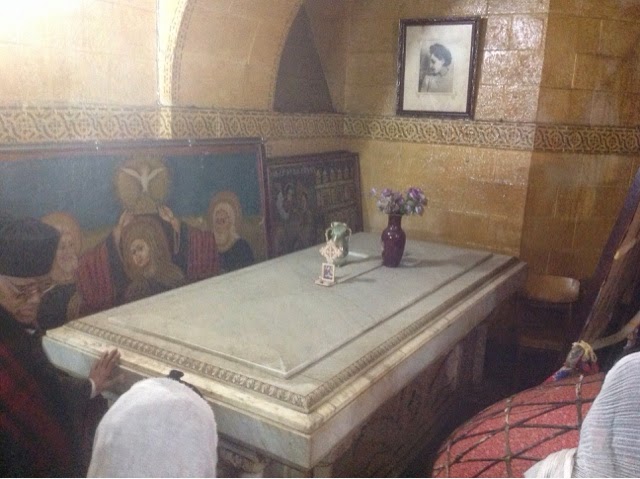So, I left our hotel and headed generally northwest, I think, toward the Old Palace enclosure. This is where the current Prime Minister lives, and where several centuries of Ethiopian kings also resided (photos not allowed). There are five large Orthodox churches on the grounds, two of which I was particularly interested in seeing: Kiddist Maryam and St. George.
Kiddist Maryam sits in a heavily wooded grove that makes it difficult to see until you're practically in front of it. This is the approach to the main entrance. Built in 1911 by Empress Zawditu, the daughter of Emperor Menelik II and Empress Taitu, as a memorial to her parents.
Tortoises roam freely around the church in a park-like setting.
Inside the church was a grand rotunda with beautiful murals on the cardinal walls depicting significant events in Ethiopia's rich history. This one shows the initial meeting of King Solomon and the Queen of Sheba in Jerusalem in about 1,000 BC. In the center of the rotunda is The Holy of Holies where the Tabot, a replica of the Ark of the Covenant, is kept.
There are 8 stone lions that guard the church; 2 at each of the 4 entrances.
The paintings and icons had an oddly European look owing to design assistance from the French.
Below the church is an eerie subterranean chamber of major historical significance. This is the mausoleum of Menelik II, his wife Taitu (left), and his daughter (right). Incense is kept burning at all times, so the space had a very smoky and mysterious quality.
At every step of the way, the Abba was providing a narrative and explaining the importance of everything in the room. Here he is describing how the drums were used. The large end was beaten to call people in from the countryside because it is very loud. The small end was beaten to call members of the royal family because it was very delicate and not as loud. He demonstrated the large end, and he was right. VERY LOUD!
At one time the remains of King Haile Selassie were held in this underground room. His body was unceremoniously kept here by his successor, the Ethiopian Communist dictator Mengistu (a seriously bad guy who actually smothered the King with a pillow on August 27, 1975), until his formal burial in November 2000 at nearby Holy Trinity Cathedral. This photo shows the sarcophagus of one of King Selassie's daughters who died at the age of 22 giving birth to her son. Her photo is on the wall.
These are the last actual thrones used by Emperor Menelik II and Taitu.
This was an incredibly small space packed full of historical artifacts and great stories!
One of two new gates being built at St. George Church.
At the foot of the sarcophagi is this amazing three dimensional representation of Jesus in his tomb. I couldn't tell what it was made of but it was mesmerizing. A small silver plaque at the feet had Greek letters on it. Even the Abba (priest) didn't know what it said.
And this shows the last actual thrones used by King Haile Selassie and his wife.
Down the hill from Kiddist Maryam is St. George Church. Although of little historical significance, it is the place in Addis favored by those living with leprosy and other crippling diseases. Because today is Sunday, there were many such people surrounding the east side of the church praying and begging for help of any kind. Taking pictures in those areas didn't seem appropriate which is why this angle makes it look almost deserted. Believe me, that was not the case on the opposite side.














hi it is not St. George it is St. Gabriel
ReplyDeletehi it is not St. George it is St. Gabriel
ReplyDelete